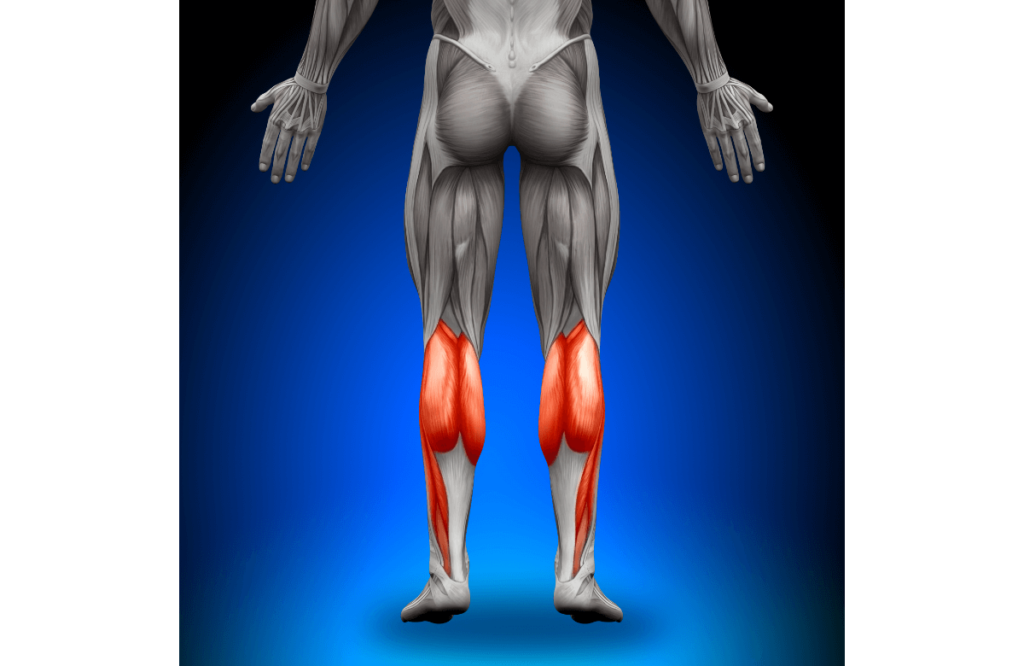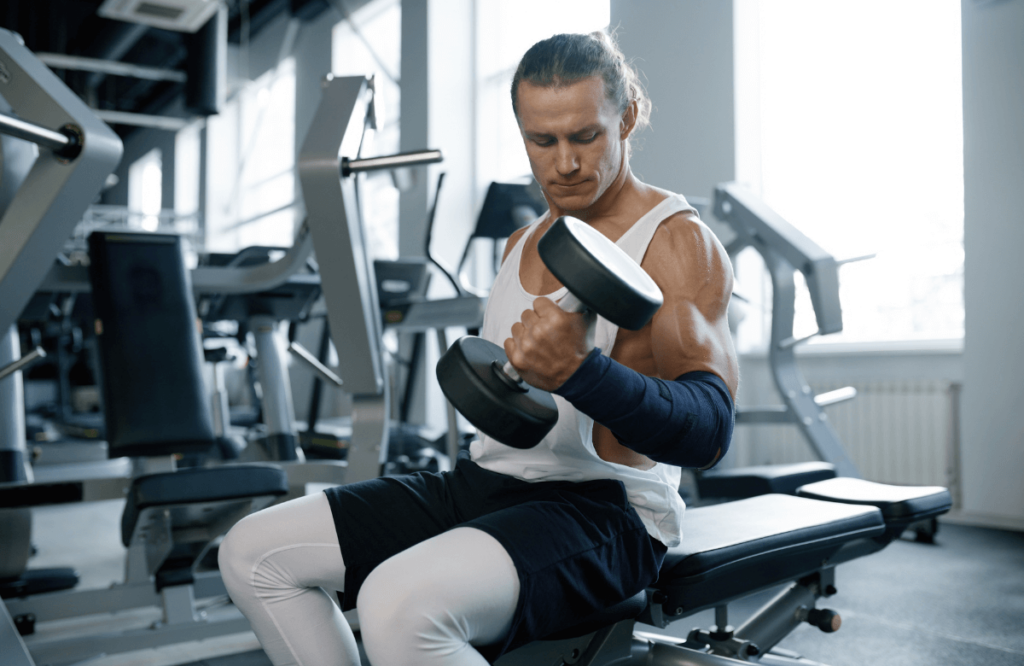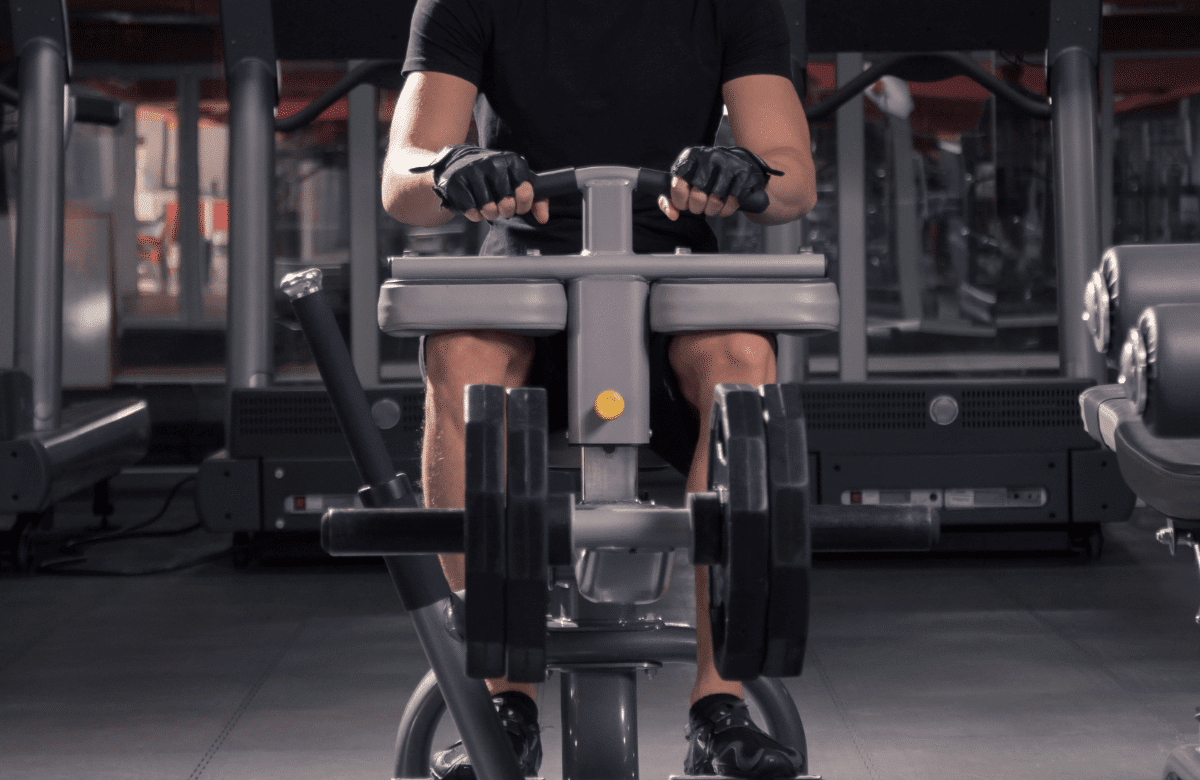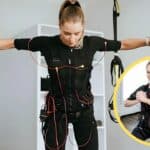Building your calves is important because it supports basic functions like taking the stairs and walking. In this article, we are going to provide you with all the information about seated calf raises. Also, we are going to tell you how to do seated calf raises at home. Let’s get started.
Jump to:
What Is a Seated Calf Raise?
The seated calf raise is the best way of improving calf muscle size and strength. It can be a machine-based or free-weight isolation movement. To perform this exercise, sit on a chair and lift your heels off the ground leaving your toes in contact with the floor. Then lower your heels down.
The seated calf raise is often performed using a seated calf raise machine, which allows you to add weight and adjust the angle of the foot platform.
Muscles Worked by the Seated Calf Raise
The seated calf raise is a great exercise to build up the soleus muscle. The soleus is the deeper muscle to the gastrocnemius and can be seen on the side of the leg. The gastrocnemius crosses the knee joint but the soleus does not. So, while performing a calf, raise bent knees reduce the focus on the gastrocnemius and increase the focus on the soleus.
For the best result, calf workouts should use bent-knee calf raises to work the soleus and straight-leg calf raises to target the gastroc. In moderate force, the gastrocnemius is preferentially activated in the eccentric phase, whereas the soleus is preferentially activated in the concentric phase.

Why the Soleus Muscle Is Important
The soleus is an important calf muscle because you will never have explosive calves until you put your focus into hitting the soleus. But you should definitely hit both calf muscles.
If you’ve ever seen somebody trying to grow their calves at the gym, they’re only doing standing calf raises all the time. They might grow that gastroc and get a nice little split and there’s some detail to it. However, you should also hit the soleus to improve the girth.
Benefits of the Seated Calf Raise
Here are the benefits of the seated calf raise:
1. Balance and Improved Stability
The seated calf raise is a wonderful exercise for everyone to stabilize the ankle and feet.
2. Stronger Calves
It prevents calf muscle weakness. You will definitely get strong calf muscles if you add this great exercise to your fitness routine.
3. Muscle Growth
You will get defined and bigger calf muscles. This exercise isolates the soleus muscle. The soleus is not a big muscle but it makes a significant contribution to the shape and size of muscularly developed calves.
4. Prevent Risk of Injury
The calf muscles are used in any movement involving the lower body. Runners take more benefits from this exercise because it reduces the risk of injury and allows them to run better.
Let’s get into the training.

How to Do Seated Calf Raises
In order to do the seated calf raise, you need to find a seated calf raise machine. You can find these in any gym that you go to.
You’re going to hop on and want your feet on the pad down. Your legs are wedged. Your toes are all the way to the end so your heels are hanging off. You are going to stand up on your toes. You are bringing your heels all the way down as far as you can stretch them. As you’re coming back up, you are up on the balls of your feet.
You are putting a lot of emphasis on your big toe. You want the pressure on your feet more to the inside on your big toe rather than on the outside. Come all the way down to a full stretch and up and squeeze your calves at the top.
Hold on the handle so it doesn’t slide off your side. Breathe out on the way up and breathe in on the way down. Keep in mind that you can pull the support edge.
We prescribe higher reps on this movement anywhere between 15-40 repetitions for women and 20-50 reps for men.
Tip #1: Stretch, Stretch, Stretch
It’s essential that we stretch that area. We can improve the elasticity to allow blood to get through to the gastrocnemius as well.
The more blood is able to get into this area and stretch the fascia that surrounds the muscle and prevents it from growing, the more growth is able to get out of this sometimes stubborn muscle group.
Once you’ve reached around 20 to 30 repetitions to absolute failure, rest and stretch out the calves during this time between sets of calf raises.
Put your foot on the end of a platform and let the heel drop down. Another stretch you can perform is up against the wall. Lean forward until you’re getting a very good stretch against the back of the lower leg.
Once you’ve rested for about a minute and you’ve stretched both legs between the set, do another set of around 20 to 30 repetitions. Do 3-5 sets of this exercise and target this calf just like any other muscle group once a week.
Tip #2: Perform High Reps
Finishing off with century sets with a little bit of tempo, specifically, rep sets where you pick up the pace a little bit. Most people argue that it’s not the way to train calves; there’s too much for calves; and you don’t get to engage those calves.
The soleus is mostly type one slow twitch muscle fibers which mean we got to destroy them performing large volume. Don’t be afraid to use a ton of volume on these. So, it is not the case to perform a 7-10 rep range to get hypertrophy, especially with calves.
Try performing a hundred reps and 3-4 sets three times a week if you want your calves to grow tremendously. That’s how you have to hit the type-1 slow twitch muscle fibers.
When you hit 50 reps, you have excruciating muscular pain and you want to quit. And from there you have to will yourself mentally to keep going. The reps are not going to be perfect after that. Performing the last 20 reps you’ll barely feel like you’re moving but that’s the right way to build bigger calves.

Common Mistakes
1. The Pad Is Too High
Make sure that the thigh pad isn’t too high because you’re not going to get a full contraction at the top. Make sure that it is placed onto your thighs when your hips drop down at the bottom. Then you’re going to lift up pushing through the inside of your toes.
2. You Push Through the Outside of Your Feet
When you perform this exercise, push all the way through the inside of your feet, not throughout the outside. When you do so, you get a better mind-muscle connection and a better contraction. It’s a stubborn muscle, so the mind-muscle connection is essential.
3. You Perform It at the End of Your Workout
People tend to do calf muscle isolation exercises at the end of their leg workouts. But if you want to build huge calves, don’t leave them as an afterthought. Make sure you prioritize and do that at the beginning of your leg workout.
4. You Lose Control of the Movement
Go up and then slowly down. Contract on the top for about a second. You want to explode up but not go ballistic and lose control of the movement.
Return to the bottom very slowly because the Achilles tendon is a very thick tendon within the back of the leg that will take over and take away the stress and load away from the muscle which is exactly what we don’t want.
So, this is an exercise where you don’t need a lot of weight; higher reps work better. When you have too much weight, you are using momentum and bouncing the weight up with your legs and feet. In this case, you’re not getting a good calf contraction and you are not effectively working the muscle. Keep in mind that it’s a slow and controlled full range of motion.
You can put heavier weight and do low reps, just remember about the full range of motion. Don’t bounce. Perform until your calves are on fire.
Seated Calf Raise Variations
1. Seated Machine Calf Raise
Using seated calf raise machines is comfortable because they come with adjustable thigh pads. What you’re going to do is a five-count positive, a five-count negative and a 10-second hold at the bottom.
This is where a training partner really comes in handy. Because it’s just too much pain, too many numbers, and you’re going to count and keep the tempo.
2. Seated Dumbbell Calf Raise
To perform seated calf raises at home, you can use a couple of dumbbells placed above the knees.
3. Seated Dumbbell Single Calf Exercise
It’s the best way to perform seated calf raises at home. Moreover, if your right calf is bigger than your left one, performing the seated dumbbell one-leg calf raise can help you change it.
4. Partial Calf Raise
Here are some benefits of the partial calf raise:
1. It’s good for overloading
You can add an extra plate of what you’d normally do.
2. It targets the Achilles tendon
If you want to strengthen the Achilles tendon, perform the partial calf raise. With this type of calf raise, you can disengage your calves.
Make sure when you’re doing this movement, once you hit the bottom, keep the feet on there but disengage your calves. Don’t keep that little slight flex that you might have. Try to relax them as much as possible and then re-engage them. Because this is the only calf exercise that pretty much you can do where you can completely disengage those calves.
5. Smith Seated Calf Raise
If you don’t have access to a seated calf raise machine, keep in mind that you can also perform the seated calf raise using the Smith machine.
Put some plates on the floor to elevate your heels. Wrap a towel or wrap a pad around the bar for comfort. Sit on a flat bench and take the bar off the rack.
This option for calf raises puts the gastrocnemius at a disadvantage which lets you specifically hone in on the soleus if that’s an area of the calves that you want to emphasize.
6. Calf Raise on the Leg Curl
It’s not the best way of building calf muscle but you can use it if you don’t have access to a seated calf raise machine. For calf growth and better results, use a couple of plates. Put your foot on the end of the plates and let your heel drop down.
Seated Calf Raises at Home: FAQs
Are seated calf raises any good?
Seated calf raises will help you build more muscular calves and improve calf muscle strength. However, you should use proper technique to see great results.
What does seated calf raises work?
Seated calf raises work and isolates the soleus. During seated calf raise exercise when your knees are bent, your gastrocnemius is deactivated. It consequently gives all the attention to the soleus muscle.














